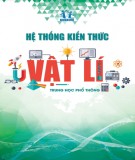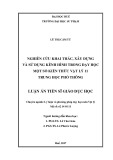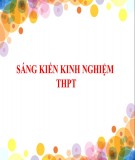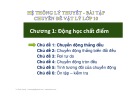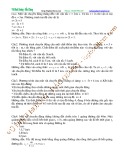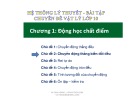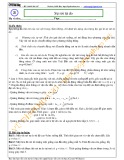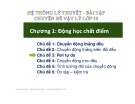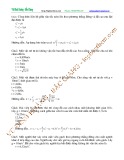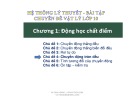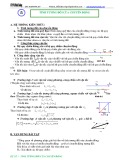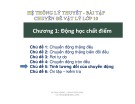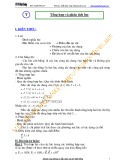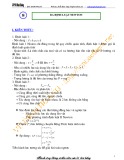Journal of Physical Science, Vol. 20(2), 13–22, 2009 13
Structural and Dielectric Properties of the Mn-Doped BaO-Nd2O3-4TiO2 System
Srimala Sreekantan*, Chong Tun Shin and Ahmad Fauzi Mohd Noor School of Materials and Mineral Resources Engineering, Universiti Sains Malaysia, 14300 Nibong Tebal, Pulau Pinang, Malaysia *Corresponding author: srimala@eng.usm.my
Abstract: The effect of the Nd2O3 and TiO2 ratios on the microstructure, dielectric properties and quality factor (Q.fr) of the 1 wt% Mn-doped BaO-Nd2O3-4TiO2 system were investigated. The samples sintered at various temperatures were analysed by field emission scanning electron microscopy (FESEM), X-ray diffraction (XRD) and a network analyser at 3 GHz. The grains of the Nd2O3 poor composition MBN0.5T4 were more spherical, whereas the grains of the excess Nd2O3 composition MBN1.5T4 were spherical and rod-like. The grains of the TiO2 poor composition MBNT4 and the TiO2 rich composition MBNT5 were more rod-like than spherical. The grain size increased with increasing sintering temperature. The BaNd2Ti5O14 phase was observed for compositions based on a BaO/Nd2O3 = 1 ratio. The composition that deviated from the BaO/Nd2O3 = 1 ratio was composed of a major phase, BaNd2Ti5O14, with some secondary phases, Nd2Ti2O7 and BaTi4O9. The formation of the secondary phases affects the density, dielectric properties and quality factor of the Mn-doped BaO-Nd2O3-4TiO2 system. The dielectric constant varies from 35–85 with different Nd2O3 and TiO2 contents. Quality factor values of 4200 to 10500 (at 3 GHz) can be obtained by varying the Nd2O3 and TiO2 contents. Keywords: Mn, dielectric properties, quality factor, BaO-Nd2O3-4TiO2 Abstrak: Kesan nisbah Nd2O3 and TiO2 ke atas mikrostruktur, sifat dielektrik dan, faktor kualiti (Q.fr) 1% berat Mn-dop BaO-Nd2O3-4TiO2 telah dikaji. Sampel yang disinter pada pelbagai suhu dianalisa dengan menggunakan mikroskop elektron imbasan (FESEM), teknik pebelauan sinar-X (XRD) dan penganalisis rangkaian pada 3 GHZ. Butiran bagi sistem MBN0.5T4 yang kekurangan Nd2O3 berbentuk sfera manakala butiran yang berlebihan kandungan Nd2O3 berbentuk rod. Saiz butiran pula didapati meningkat dengan suhu persekitaran. Fasa BaNd2Ti5O14 terbentuk bagi sampel dengan nisbah BaO/Nd2O3 = 1. Selain daripada komposisi didapati sampel mengandungi fasa utama BaNd2Ti5O14 bersama fasa sekunder Nd2Ti2O7 dan BaTi4O9. Pembentukan Fasa sekunder mempengaruhi ketumpatan, sifat dielektrik dan faktor kualiti sistem Mn-dop BaO-Nd2O3-4TiO2. Pemalar dielektrik berubah dari 35–85 dengan kandungan Nd2O3 dan TiO2 yang berlainan. Faktor kualiti yang bernilai 4200 hingga 10500 (pada 3 GHz) boleh dicapai dengan mengubah kandungan Nd2O3 dan TiO2. Kata kunci: Mn, sifat dielektrik, faktor kualiti, BaO-Nd2O3-4TiO2
INTRODUCTION
Structural and Dielectric Properties of the Mn-Doped 14 1.
Modern microwave
telecommunication systems
require ceramic dielectric resonators (DR) that exhibit a high quality factor (Q ≅ (tan δ)-1) and relative permittivity (εr) and a near-zero temperature coefficient of resonant frequency (τf).1,2 Despite their technical importance and widespread use, only a very few ceramic materials are known that meet these stringent property requirements. In the early days, TiO2 attracted substantial attention due to its high relative permittivity (εr~100) and high quality factor (Q.fr ~50000 at 3 GHz).3 Subsequent development resulted in useful compounds in the BaO-TiO2 system. One of the materials described as having practical applications as a DR was BaTi4O9, which has an εr~38 and Q.fr ~28160 at 11GHz.4 These results provoked exploration of materials in several BaO-M2O3-TiO2 systems, where M is a rare earth species. The first system to be investigated was BaO-Nd2O3-TiO3. A later work by Kolar et al.5 reported a compound with a molar ratio near BaO- Nd2O3.5TiO2 that was identified as having practical microwave properties because it exhibited εr~77 and Q.fr~17600. It is generally accepted that the characteristics of BaO–Nd2O3–TiO2 ceramics strongly depend on their crystal structure, stoichiometry, grain size, additives and phase composition.6–9 Consequently, numerous approaches existed for modifying the characteristic of BaO-Nd2O3-TiO2 including (1) doping with additives of SrO, PbO, Ta2O5 and other rare earth oxides10–14 and (2) varying the composition. As for this work, we have attempted to vary the composition by changing the ratio of Nd2O3 and TiO2 in 1 wt% Mn-doped BaO-Nd2O3-4TiO3 system. The effects of compositional change upon the microstructure, dielectric properties and quality factor are reported in this study. Mn of 1 wt% was added to all the compositions in our experiment because, in our previous work, we acknowledged that Mn addition promotes densification of BaO-Nd2O3-4TiO3 and enhances the quality factor of the system.15
EXPERIMENTAL
2.
Samples were prepared by the conventional method using BaCO3. TiO2, MnO and Nd2O3 powders of high purity above 99.9% (Merck, Germany). The compositions investigated in this study are summarised in Table 1.
Journal of Physical Science, Vol. 20(2), 13–22, 2009 15
Table 1: Composition of the samples.
Sample MBN0.5T4 MBNT4
MBN1.5T4
MBNT5
Composition 1BaO-0.5Nd2O3-4TiO2 with 1 wt% Mn 1BaO-1Nd2O3-4TiO2 with 1 wt% Mn 1BaO-1.5Nd2O3-4TiO2 with 1 wt% Mn 1BaO-1Nd2O3-5TiO2 with 1 wt% Mn
RESULTS AND DISCUSSION
Mixing was carried out in a polyethylene bottle containing zirconia balls and deionised water. The mixture was calcined at 1150oC for 2 h, dried, crushed and then pressed with a cylindrical mould with a diameter of 16 mm under a pressure of 150 MPa to yield samples in pellet form. The specimens were sintered at various temperatures in the range of 1200oC to 1400oC for 2 h. The relative densities of the sintered samples were measured using a densitometer. Phase analysis was performed using a Bruker D8 powder diffractometer operating in reflection mode with Cu Kα radiation. Microstructure observation was conducted using a field emission scanning electron microscope (FESEM SUPRA 35VP ZEISS) operating at working distances down to 1 mm and an extended accelerating voltage range from 30 kV down to 100 V. Samples for εr and Q.fr measurements were prepared from sintered pellets by polishing both faces of the pellets with SiC paper (1000) followed by 0.1 μm Al2O3 paste. The εr and Q.fr were measured using a network analyser at 3 GHz. 3. 3.1 Microstructure
Figure 1 shows the microstructures of sintered MBNT4 at different sintering temperatures (1250oC, 1300oC and 1350oC). Both spherical and rod- shaped grains were observed in the sample sintered at 1250oC. The diameter of the spherical grains and rod-like grains are similar in the range of 0.5 to 0.8 μm. The lengths of the rod-like grains were of 2.0 to 2.5 μm. As the temperature was increased to 1300oC, the grains became slightly larger, with diameters of 1.0 to 1.2 μm. The lengths of the rod-like grains were approximately 2.0 to 4.0 μm. By increasing the sintering temperature to 1350oC, the spherical grains disappeared, and rod-like grains with diameters of 1.5 to 2.0 μm and lengths of 8.0 to 10.0 μm were observed. The change in the shape suggests that the grain growth occurs along orthorhombic a or b axes because these axes are longer than the c axis in the orthorhombic structure.
Structural and Dielectric Properties of the Mn-Doped 16
2 µm
2 µm
2 µm
(a)
(b)
(c)
Figure 1: SEM micrographs of sintered MBNT4 at different sintering temperatures:
(a) 1250oC, (b) 1300oC and (c) 1350oC.
Figure 2 shows the microstructures of the sintered samples (1300oC, 2 h) with different compositions. Both spherical and rod-like grains were observed in all the samples. The grains of the Nd2O3 poor composition MBN0.5T4 were mostly spherical with little rod-like structure. For the excess Nd2O3 composition MBN1.5T4, the grains were mostly rod-like with little spherical structure. The shapes of the grains in MBNT4 comprised both spherical and rod-like, whereas the grains in the excess TiO2 composition, MBNT5, were mostly rod-like. The grain sizes in MBN0.5T4 and MBNT4 were relatively small compared to those of MBN1.5T4 and MBNT5. This result is in agreement with the results reported by Chen et al11 and Fu et al.16, in which they found that excess Nd2O3 and excess TiO2 promote grain growth.
2 µm
2 µm
2 µm
(a) MBN0.5T4, (b) MBN1.5T4 and (c) MBNT5.
(a) (b) (c) Figure 2: SEM micrographs of the sintered samples with different compositions:
XRD Results
Journal of Physical Science, Vol. 20(2), 13–22, 2009 17 3.2
The corresponding XRD patterns of the four different compositions are shown in Figure 3. The patterns for all the compositions fit well with the orthorhombic phase of standard BaNd2Ti5O14, ICDD No 33–136. The lattice parameters of the XRD show a = 12.20 Å, b = 22.35 Å and c = 3.84 Å. However, detailed observation shows the presence of extra peaks in MBN0.5T4 and MBN1.5T4. The extra peaks in MBN0.5T4 and MBN1.5T4 were identified as BaTi4O9 and Nd2Ti2O7, respectively. Nd2Ti2O7 compounds may have formed because the excess Nd2O3 reacted with TiO2, whereas BaTi4O9 compounds may have formed because the BaTiO3 reacted with excess TiO2. However, XRD peaks that correspond to MnO were not detected in any of the compositions, probably due to the small content of MnO in the samples.
) u . a ( y t i s n e t n I
30
20
60
50
40
2θ
(a) • • • • • • • • • • • • • • • • • • • • • • • • • • ••• • • • (b) • • • • • • • • • • • • • • • • • • • • • • • • • • ••• • • • ♣ • • (c) ♣ ♣ ♣ • • • • • ♣ ♣ • • •• • • • • • ♣ • ♦ • ♣ • ♣ • ♦ ♦ • (d) ♦ • • • • • • ♦ • ♦ • • • •• • • • • • •
Figure 3: XRD patterns of the four different compositions: (a) MBNT5, (b) MBNT4, (c) MBN0.5T4 and (d) MBN1.5T4. [(•) BaNd2Ti5O14, (♦) Nd2Ti2O7, (♣)BaTi4O9]
Density
3.3
influence
Various factors
the microwave properties of dielectric materials, including the contents of individual crystalline, secondary phases and the degree of densification. Therefore, a series of experiments was performed to find the optimum densification of each sample. Figure 4 presents the densities of MBNT4, MBNT5, MBN0.5T4 and MBN1.5T4 sintered at various temperatures for 2 h.
6.0
5.8
5.6
5.4
)
MBNT4
MBN1.5T4
3 –
) 3
5.2
5.0
4.8
MBN0.5T4
m c / g ( y t i s n e d
m c g ( y t i s n e D
4.6
4.4
MBNT5
4.2
4.0
1300
1350
1150
1200
1250
1400
1450
sintering temperature (oC) Sintering temperature (°C)
Structural and Dielectric Properties of the Mn-Doped 18 Figure 4: Densities of samples sintered at various temperature for 2 h. [((cid:0)) MBNT5, (♦)
MBNT4, ( ▲ ) MBN0.5T4 and (Ο) MBN1.5T4].
Dielectric Properties
The sintered density of MBNT5 was higher than MBNT4 at a given sintering temperature. This behaviour could be explained by considering the microstructure changes of MBNT5, which showed elongated grain and high porosity compared to MBNT4. MBNT5 showed a maximum density of 4.7 gcm–3 at 1250oC, whereas MBNT4 showed a maximum density of 5.4 gcm–3 at 1300oC. This result indicates that the excess TiO2 in MBNT5 promotes densification at low temperature, and this might be due to the TiO2 having a lower melting temperature than other oxides.16 The density of the composition containing excess Nd2O3 (MBN1.5T4) increased gradually with sintering temperature and showed a maximum density of 5.3 gcm–3 at 1400oC, whereas the composition containing less Nd2O3 (MBN0.5T4) shows a maximum density (4.8 gcm–3) at 1250oC, which declined as the sintering temperature increased. This result suggests that the composition containing more Nd2O3 requires high temperature for interdiffusion of the Nd2O3, which has a high melting temperature, into a chemically and crystallographically uniform structure to attain maximum density.11 3.4 Figure 5 shows the changes in dielectric constant at 3 GHz as a function of sintering temperature with different compositions. The sample with composition MBNT4 showed the highest dielectric constant in the range of 75 to 85 with different sintering temperatures. The value of the dielectric constant
90
MBNT4
80
70
60
50
l
i
t n a t s n o c c i r t c e e d
MBN0.5T4
t n a t s n o c c i r t c e l e i D
40
MBNT5
30
MBN1.5T4
20
1350
1400
1150
1450
1300
1200
1250
sintering temperature (oC) Sintering temperature (°C)
Journal of Physical Science, Vol. 20(2), 13–22, 2009 19 decreased by 50% as the TiO2 content increased (MBNT5). Furthermore, the results also demonstrate that the sintering temperature to achieve maximum dielectric value decreased as TiO2 increased. For example, the maximum dielectric of MBNT4 was 85, and it was attained at 1300oC, whereas for MBNT5, the maximum dielectric constant, 60, was obtained at 1250oC. The trend of this result indicates that the dielectric constant is closely related to the density changes in Figure 4. This can be explained by considering the capacitance of a porous sample and a dense sample. For the porous sample, the total capacitance comprises the capacitance of the grain and air in the pores. It is well known that the capacitance of air is very much less than that of the grains.17 Therefore, the less dense sample has a lower dielectric constant than the dense sample. The composition containing excess Nd2O3, MBNT1.5T4, has a dielectric constant below 55, and the maximum dielectric constant was obtained at 1400oC. The composition containing less Nd2O3, MBNT0.5T4, has a dielectric constant below 60, and the maximum dielectric constant was obtained at 1250oC and 1300oC. In summary, the dielectric constants for the samples with compositions deviating from a BaO/Nd2O3 = 1 ratio were relatively low, and this might be due to the presence of the secondary phase Nd2Ti2O7 and BaTi4O9 compound. Figure 5: Dielectric of samples sintered at various temperature for 2 h. [((cid:0)) MBNTS,
(♦) MBN0.5T4, ( ▲ ) MBN0.5T4, (Ο) MBN1.5T4]
Quality Factor (Q.fr)
12000
11000
10000
) r f .
9000
f .
Q
Q
8000
7000
r o t c a f y t i l
a u Q
6000
( r o t c a f y t i l a u Q
5000
4000
3000
1150
1450
1250
1300
1400
1200
1350
sintering temperature (oC) Sintering temperature (°C)
Structural and Dielectric Properties of the Mn-Doped 20 3.5 The effect of sintering temperature on the Q.fr of Mn-doped BaO-Nd2O3- 4TiO2 is shown in Figure 6. As the proportion of TiO2 increased in MBNT, the samples exhibited excellent Q.fr values. For example, the Q.fr of MBNT5 was in the range of 9000 to 10500, whereas for MBNT4, the Q.fr value was in the range of 7000–8500. The enhancement in the Q.fr value in MBNT5 is probably due to the fact that TiO2 has a high Q.fr value. The composition containing less Nd2O3 showed a higher Q.fr value than the composition containing excess Nd2O3. This fact could be explained by the existence of the secondary phase Nd2Ti2O7 in MBN1.5T4, which is known to have a low Q value, and BaTi4O9 compound in MBN0.5T4, which is known to have a high Q value.18 Figure 6: Quality factors of samples sintered at various temperatures for 2 h.
[((cid:0)) MBNT5, (♦) MBNT4, (▲) MBNO. 5T4 and (Ο) MBN1.5T4.
CONCLUSION
4.
The Nd2O3 and TiO2 ratio control the density, dielectric constant, quality factor, phase and microstructure of 1 wt% Mn-doped BaO-Nd2O3-4TiO2. The proportions of spherical and rod-like grains depend on the composition and sintering temperature. The pure phase was obtained for a BaO/Nd2O3 ratio = 1, and any deviation from this ratio causes the formation of secondary phases.
ACKNOWLEDGEMENTS
Journal of Physical Science, Vol. 20(2), 13–22, 2009 21 Excess Nd2O3 in the composition increased the sintering temperature for a maximum density, whereas excess TiO2 decreased it. The dielectric constant was high for a BaO/Nd2O3 ratio = 1 and deteriorated when the ratio deviated from 1 due to secondary phase formation. The value of the quality factor decreased as Nd2O3 increased. In contrast, the quality factor value increased as TiO2 increased. 5.
REFERENCES
The author would like to thank Universiti Sains Malaysia for sponsoring this work under Short Term Grant 2008 (6035276) and MOSTI for sponsoring it under the eScience fund (6013357). 6. 1.
2.
their application
resonator materials and
3.
4.
5.
6.
7.
8.
9.
10.
Wersing, W. (1996). Microwave ceramics for resonators and filters. Curr. Opin. Solid State Mater. Sci., 11, 715–731. Wakino, K., Nishikawa, T., Ishikawa, Y. & Tamura, H. (1990). Dielectric for mobile communication systems. Br. Ceram. Trans. 89, 39–43. Moulson, A. J. & Herbert, J. M. (1990). Electroceramics: Materials, properties and applications. London: Chapman & Hall. Masse, D. J., Pucel, R. A., Readey, D. W., Maguire, E. A. & Hartwig, C. P. (1971). A new low-loss high K temperature-compensated dielectric for microwave applications. Proc. IEEE, 59, 1628–1632. Kolar, D. & Suvorov, D. (1998). High permittivity microwave ceramics. Eur. J. Solid State and Inorg. Chem., 32, 751–760. Skapin, S., Kolar, D., Suvorov, D. & Samardzija, Z. (1998). Phase equili- bria in the BaTiO3-La2TiO5-TiO2 system. J. Mater. Res., 13(5), 1327. Srimala, S., Ahmad, F. M. N., Zainal, A. A., Radzali, O., West, A. & Sinclair, D. (2007). Impedance spectroscopy of Ba0.9Sr0.1TiO3 prepared by low temperature aqueous synthesis. J. Mater. Sci., 42, 2492–2498. Srimala, S., Ahmad, F. M. N., Zainal, A. A., Radzali, O. & West, A. (2008). Structural and electrical characteristic of crystalline barium titanate synthesized by low temperature aqueous method. J. Mater. Process. Techno., 195, 171–177. Zhu, J., Lu, W., Lei, W. & Wan, S. (2009). Effects of SrTiO3 additives on the structure and microwave dielectric properties of Ba4.2Sm9.2Ti18O54 ceramics. Ceram. Int., 35, 855–860. Pei, J., Yue, Z., Zhao, F., Gui, Z. & Li, L. (2009). Microstructure and dielectric properties control of Ba4(Nd0.7Sm0.3)9.33 Ti18O54 microwave ceramics. Ceram. Int., 35, 253–257.
Structural and Dielectric Properties of the Mn-Doped 22 11.



